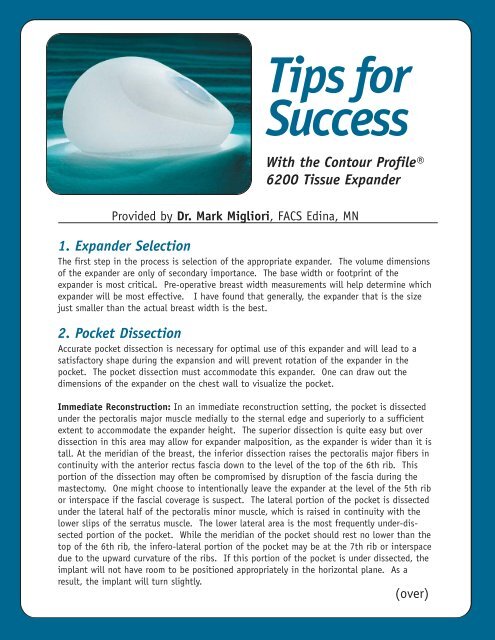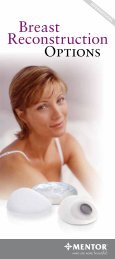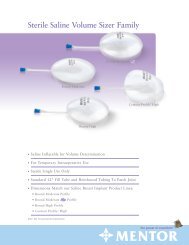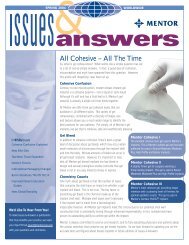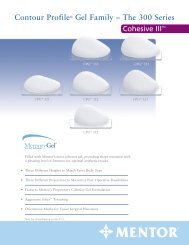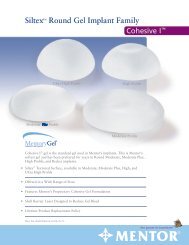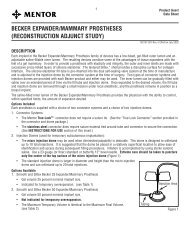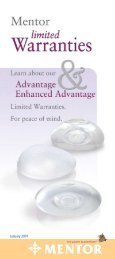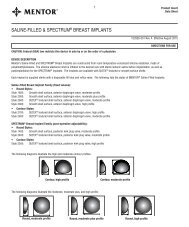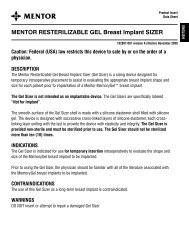Tips for Success With the Contour Profile® 6200 Tissue ... - Mentor
Tips for Success With the Contour Profile® 6200 Tissue ... - Mentor
Tips for Success With the Contour Profile® 6200 Tissue ... - Mentor
You also want an ePaper? Increase the reach of your titles
YUMPU automatically turns print PDFs into web optimized ePapers that Google loves.
<strong>Tips</strong> <strong>for</strong><br />
<strong>Success</strong><br />
<strong>With</strong> <strong>the</strong> <strong>Contour</strong> Profile®<br />
<strong>6200</strong> <strong>Tissue</strong> Expander<br />
Provided by Dr. Mark Migliori, FACS Edina, MN<br />
1. Expander Selection<br />
The first step in <strong>the</strong> process is selection of <strong>the</strong> appropriate expander. The volume dimensions<br />
of <strong>the</strong> expander are only of secondary importance. The base width or footprint of <strong>the</strong><br />
expander is most critical. Pre-operative breast width measurements will help determine which<br />
expander will be most effective. I have found that generally, <strong>the</strong> expander that is <strong>the</strong> size<br />
just smaller than <strong>the</strong> actual breast width is <strong>the</strong> best.<br />
2. Pocket Dissection<br />
Accurate pocket dissection is necessary <strong>for</strong> optimal use of this expander and will lead to a<br />
satisfactory shape during <strong>the</strong> expansion and will prevent rotation of <strong>the</strong> expander in <strong>the</strong><br />
pocket. The pocket dissection must accommodate this expander. One can draw out <strong>the</strong><br />
dimensions of <strong>the</strong> expander on <strong>the</strong> chest wall to visualize <strong>the</strong> pocket.<br />
Immediate Reconstruction: In an immediate reconstruction setting, <strong>the</strong> pocket is dissected<br />
under <strong>the</strong> pectoralis major muscle medially to <strong>the</strong> sternal edge and superiorly to a sufficient<br />
extent to accommodate <strong>the</strong> expander height. The superior dissection is quite easy but over<br />
dissection in this area may allow <strong>for</strong> expander malposition, as <strong>the</strong> expander is wider than it is<br />
tall. At <strong>the</strong> meridian of <strong>the</strong> breast, <strong>the</strong> inferior dissection raises <strong>the</strong> pectoralis major fibers in<br />
continuity with <strong>the</strong> anterior rectus fascia down to <strong>the</strong> level of <strong>the</strong> top of <strong>the</strong> 6th rib. This<br />
portion of <strong>the</strong> dissection may often be compromised by disruption of <strong>the</strong> fascia during <strong>the</strong><br />
mastectomy. One might choose to intentionally leave <strong>the</strong> expander at <strong>the</strong> level of <strong>the</strong> 5th rib<br />
or interspace if <strong>the</strong> fascial coverage is suspect. The lateral portion of <strong>the</strong> pocket is dissected<br />
under <strong>the</strong> lateral half of <strong>the</strong> pectoralis minor muscle, which is raised in continuity with <strong>the</strong><br />
lower slips of <strong>the</strong> serratus muscle. The lower lateral area is <strong>the</strong> most frequently under-dissected<br />
portion of <strong>the</strong> pocket. While <strong>the</strong> meridian of <strong>the</strong> pocket should rest no lower than <strong>the</strong><br />
top of <strong>the</strong> 6th rib, <strong>the</strong> infero-lateral portion of <strong>the</strong> pocket may be at <strong>the</strong> 7th rib or interspace<br />
due to <strong>the</strong> upward curvature of <strong>the</strong> ribs. If this portion of <strong>the</strong> pocket is under dissected, <strong>the</strong><br />
implant will not have room to be positioned appropriately in <strong>the</strong> horizontal plane. As a<br />
result, <strong>the</strong> implant will turn slightly.<br />
(over)
<strong>Tips</strong> <strong>for</strong> <strong>Success</strong><br />
<strong>With</strong> <strong>the</strong> <strong>Contour</strong> Profile® <strong>6200</strong> <strong>Tissue</strong> Expander<br />
(Page 2)<br />
Delayed Reconstruction: In a delayed reconstruction setting, <strong>the</strong> pocket dimensions are similar but<br />
<strong>the</strong> dissection may be simplified if <strong>the</strong> soft tissue coverage is durable and pliable. For instance, <strong>the</strong><br />
pocket should still be dissected down to <strong>the</strong> top to <strong>the</strong> sixth rib but one might choose to divide <strong>the</strong><br />
fascial plane between <strong>the</strong> pectoralis muscle and <strong>the</strong> anterior rectus fascia leaving <strong>the</strong> anterior rectus<br />
fascia against <strong>the</strong> chest wall. Also, <strong>the</strong> serratus and pectoralis minor dissections can be avoided,<br />
allowing <strong>the</strong> expander to be subcutaneous infero-laterally. Doing this assumes that <strong>the</strong> lateral skin<br />
flaps are of sufficient thickness and durability to withstand <strong>the</strong> expansion. However, <strong>the</strong> respect <strong>for</strong><br />
matching pocket size and expander dimension should be maintained.<br />
3. Expander Placement<br />
<strong>With</strong> <strong>the</strong> pocket dissected, <strong>the</strong> expander is removed from its packaging, sterile saline is injected into<br />
<strong>the</strong> expander using a closed filling system and <strong>the</strong> residual air is removed. Typically, 60-120 ccs are<br />
placed into <strong>the</strong> expander at this time. The expander is <strong>the</strong>n slipped into <strong>the</strong> submuscular pocket in<br />
<strong>the</strong> appropriate orientation. Care is taken to ensure that <strong>the</strong> back panel lies flat in <strong>the</strong> pocket and<br />
in <strong>the</strong> appropriate horizontal plane. The muscle pocket is closed allowing <strong>for</strong> complete coverage of<br />
<strong>the</strong> expander. The expander can now be filled so that <strong>the</strong>re is slight tension within <strong>the</strong> pocket.<br />
Depending on <strong>the</strong> patient’s tissue characteristics, this is typically anywhere from 60 to 240 cc’s.<br />
Using <strong>the</strong> orientation tab: To aid in <strong>the</strong> maintenance of this orientation during <strong>the</strong> early post-operative<br />
period, a soft, absorbable suture can be place at <strong>the</strong> inferior pole of <strong>the</strong> pocket at <strong>the</strong> meridian<br />
and placed through <strong>the</strong> rein<strong>for</strong>ced orientation tab at <strong>the</strong> base of <strong>the</strong> implant. *Ensure that <strong>the</strong><br />
suture is placed through <strong>the</strong> suture tab prior to placing <strong>the</strong> expander in <strong>the</strong> pocket as this will minimize<br />
<strong>the</strong> chance of accidental puncture. This suture can be placed through <strong>the</strong> rib periosteum or<br />
through <strong>the</strong> external intercostals muscle. It is not a strength stitch and should only be secured<br />
after <strong>the</strong> expander is appropriately positioned.<br />
4. Drains<br />
Rotation of an expander may be promoted by <strong>the</strong> presence of peri-expander fluid in <strong>the</strong> early postoperative<br />
period. Drains may help in this regard. The majority of <strong>the</strong> fluid will accumulate in <strong>the</strong><br />
subcutaneous mastectomy space and a drain should be placed superficial to <strong>the</strong> pectoralis muscle.<br />
It may also be helpful to place a small drain in <strong>the</strong> submuscular space until <strong>the</strong> first expansion.<br />
Once expansion begins, <strong>the</strong> pressure of <strong>the</strong> expander should hold it in <strong>the</strong> appropriate position.<br />
5. Post-surgical Garments<br />
Pressure garments or taping should be avoided in <strong>the</strong> immediate post-mastectomy patient to avoid<br />
compromising <strong>the</strong> skin flap vascularity. In a delayed tissue expander reconstruction, however, <strong>the</strong>se<br />
dressing techniques may be safer and may prove helpful to avoid peri-expander fluid accumulation<br />
and malposition.<br />
Appropriate timing of first expansion is a matter of personal preference. Most patients will require a<br />
couple weeks of recovery be<strong>for</strong>e <strong>the</strong>y are ready <strong>for</strong> <strong>the</strong>ir first expansion. Weekly or bi-weekly expansions<br />
of 60-100ccs are usually well tolerated.<br />
©November 2002 <strong>Mentor</strong> 0210033


